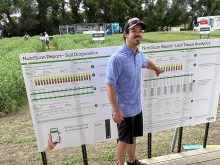ABERDEEN, Sask. – Rain pelted down and cool temperatures made July 9 feel like May 9.
But for canola plants hit by drought, frost and insects and slow to mature because of sustained cool weather, the rain was an improvement.
And while it was not an ideal day for an outdoor event, complaints were few as Cargill opened its new specialty oils canola research centre at Aberdeen, Sask.
“It’s a good day to be canola and I don’t think the farmers here mind having the rain,” said Jenny Verner of Cargill Specialty Oils.
Read Also

New fertilizer product aims to reduce tie-up, improve soil health
A new phosphorus fertilizer, launched at Ag in Motion 2025, promises to reduce nutrient tie-up and deliver slow-release feeding throughout the growing season.
Verner of Minneapolis said locating Cargill’s newest research facility northeast of Saskatoon was an easy decision for the company.
“This is where canola is grown. When we develop products for farmers, it makes sense to do it in the place where they will be used,” she said.
Len Penner, president of Cargill in Canada, said choosing to invest in Canadian processing and research makes him feel confident about the western Canadian agricultural economy.
He said Cargill believes the international market for canola is headed toward specialty oils with profiles supporting human health.
The new oils being developed at Aberdeen will grow in consumer demand and market share.
Verner said Cargill’s food ingredient customers in the processing or food service sectors are seeking an edge in the market.
“They want an advantage. Longer shelf life in baked goods. Better fryer life.
“(Consumer) demanded products they feel are a benefit to health, especially for the aging demographic that form a large part of the market,” she said.
“Farmers, processors, food service, these are all our customers. From high-yielding canola hybrids to farmers that ultimately result in oils with zero grams trans fats and lower saturated fat, it’s a chain. We provide the links and hope to make them all successful so they buy more from us,” she said.
Penner said the 15,500 sq. foot facility will provide information for farmers and consumers.
Recent fertilizer price trends for some nitrogen products were higher compared to early July, according to the United States Department of Agriculture. Potash was lower.
USDA surveys input costs in Illinois every two weeks. The following prices are in U.S. dollars per short ton and compare prices July 23 to July 9.
The range for urea 46-0-0 was steady at $350 to $525. The average was also steady at $424.80.
Anhydrous ammonia was steady at $500 to $605. The average was $568.13, up $6.25.
Liquid nitrogen 28-0-0 was $225 to $380, up from a range of $187 to $380 in the previous period, with an average of $306.30, up $12.70.
Diammonium phosphate 18-46-0 was $400 to $520. The average was $453.50, up 3.33.
Potash was down at $695 to $810. The average was $758.91, down $2.48.














